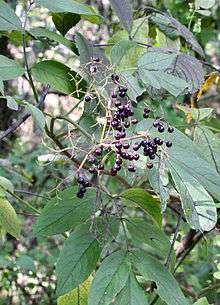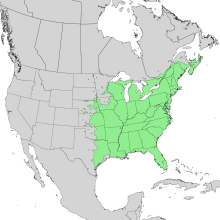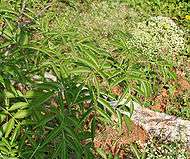Sambucus canadensis
| Sambucus canadensis | |
|---|---|
 | |
| Foliage and fruit | |
| Scientific classification | |
| Kingdom: | Plantae |
| Clade: | Angiosperms |
| Clade: | Eudicots |
| Clade: | Asterids |
| Order: | Dipsacales |
| Family: | Adoxaceae |
| Genus: | Sambucus |
| Species: | S. canadensis |
| Binomial name | |
| Sambucus canadensis | |
 | |
| Natural range of Sambucus canadensis | |
| Synonyms | |
|
Sambucus nigra subsp. canadensis (L.) Bolli | |
Sambucus canadensis, the American black elderberry, Canada elderberry, or common elderberry, is a species of elderberry native to a large area of North America east of the Rocky Mountains, and south through eastern Mexico and Central America to Panama. It grows in a variety of conditions including both wet and dry soils, primarily in sunny locations.
Description
It is a deciduous suckering shrub growing to 3 m or more tall. The leaves are arranged in opposite pairs, pinnate with five to nine leaflets, the leaflets around 10 cm long and 5 cm broad. In summer, it bears large (20–30 cm diameter) corymbs of white flowers above the foliage, the individual flowers 5–6 mm diameter, with five petals.
The fruit (known as an elderberry) is a dark purple to black berry 3–5 mm diameter, produced in drooping clusters in the fall.
Taxonomy
It is closely related to the European Sambucus nigra, and some authors treat it as conspecific, under the name Sambucus nigra subsp. canadensis.[1]
Uses
The flower (known as an elderflower) is edible, as well as the ripe berries. Other parts of the plant, such as leaves, stems, roots, and unripe fruits, are toxic due to the presence of cyanogenic glycosides, and alkaloids.[2]
Uses for the fruit include medicinal purposes based on their medicinal virtues: The bark, leaves, flowers and berries (high in Vitamin C-supports immune function) all have medicinal properties so they not only have proved their usefulness over thousands of years, but are a valuable remedy in modern herbal medicine as well,[3] wine, jelly and dye. Leaves and inner bark can be used as an insecticide and a dye.[4] Stems can be hollowed out and used for spouts, musical instruments, and toys.
Gallery
 Flowers
Flowers Foliage
Foliage- Fruits
References
- ↑ "Sambucus nigra". Integrated Taxonomic Information System.
- ↑ "Sambucus canadensis". North Carolina State Extension.
- ↑ Nicholas Culpeper, David Potterton (Editor), Michael Stringer (Illustrator), & E.J. Shellard (Forward), Culpeper's Color Herbal: (New York:Sterling Publishing Co, Inc., 1983), 65-66.
- ↑ "Sambucus canadensis". Plants for a Future.
- "Sambucus canadensis". Germplasm Resources Information Network (GRIN). Agricultural Research Service (ARS), United States Department of Agriculture (USDA). Retrieved 26 December 2017.
- Missouri Plants
- Missouri State Fruit Experiment Station
External links

- USDA Plants Profile: Sambucus nigra subsp. canadensis
- Vanderbilt University Bioimages photo gallery: Sambucus nigra ssp. canadensis
